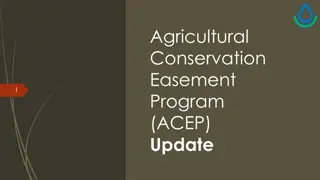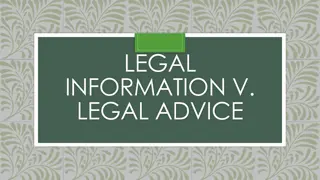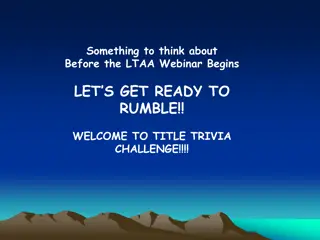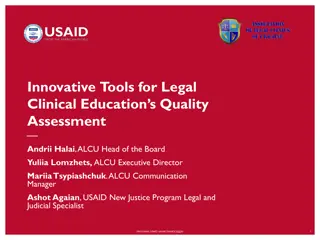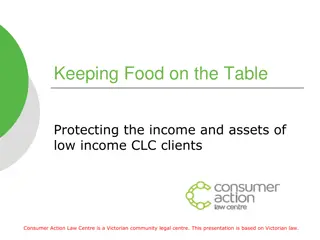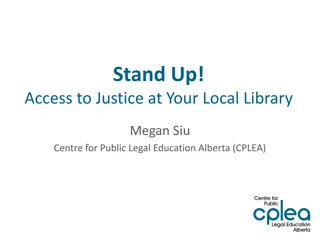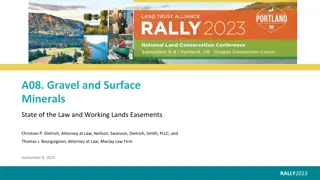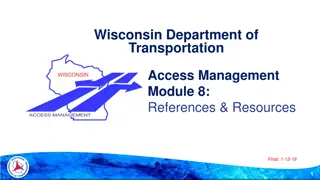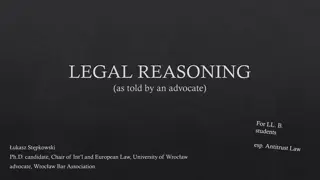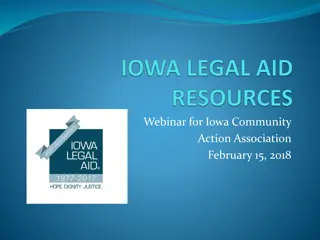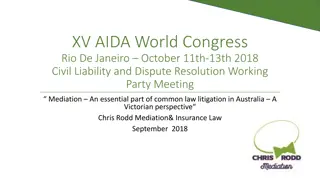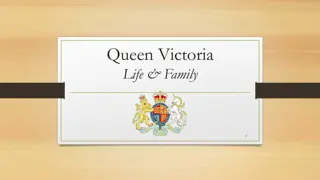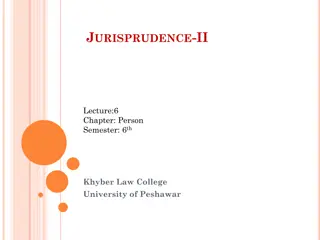Understanding Legal Responsibilities Related to Easements in Victoria
Easements are rights allowing use of someone's land without occupying it, with implications for both dominant and servient owners. Private and regulatory easements are common in Victoria, created through agreements or vendor reservations. Statutory easements are now regulated by planning legislation, protecting rights associated with subdivision and unregistered easements.
Download Presentation

Please find below an Image/Link to download the presentation.
The content on the website is provided AS IS for your information and personal use only. It may not be sold, licensed, or shared on other websites without obtaining consent from the author. Download presentation by click this link. If you encounter any issues during the download, it is possible that the publisher has removed the file from their server.
E N D
Presentation Transcript
LEGAL RESPONSIBILITIES RELATING TO EASEMENTS Michael Mammen Partner, HWL Ebsworth Lawyers
Easements- Overview What is an easement? An easement is a right to make use of someone's land without occupying it. These rights are vested in the land rather than individuals, meaning they can be enforced against subsequent owners and occupiers. The rights and obligations parties attract from an easement will depend on what type of easement is created, and how the easement is created.
Types of Easements There are three types of easements that operate in Victoria 1. Private Easements 2. Regulatory Easements 3. Common Law Prescriptive Easements Most easements in Victoria today are either private or regulatory easements. Prescriptive easements are now exceptionally rare due to the introduction of planning legislation covering the creation of subdivisional easements.
Private Easements There are two parties affected by a private easement. Dominant owner: the dominant owner has title to the dominant land. Servient owner: the servient owner is the owner to the servient land. The dominant owner has the right to enjoy the servient land in the way specified in the easement. The servient owner has the obligation to accommodate the dominant owner s right to enjoy their land.
Creation of Private Easements A private easement will always be the result of an agreement between a dominant and servient owner. Consequently, the parties creating a private easement will determine the content of rights and obligations they and all subsequent owners will have with respect to the easement. Parties can determine these rights in two ways: 1. The servient owner may grant the dominant owner an easement over their land 2. A vendor may reserve an easement over the land when conveying it to a purchaser for the benefit of other adjacent land the vendor owns.
Statutory Easements Planning legislation serves two key functions with respect to easements. Legislation regulates the creation of easements through subdivision Legislation protects unregistered easements. Rights and obligations associated with these aspects of easement law were traditionally protected under a complex and unsystematic part of the common law. It is now exceptionally rare for parties to rely on the common law to assert their rights with respect to easements.
Express subdivisional easements Today, most easements needed for access to land and the provision of services are created by plan of subdivision or by an instrument of transfer on sale. This method of creating these easements is governed by section 12(1) of the Subdivision Act 1988 (Vic) (Subdivision Act) and s 98(a) of the Transfer of Land Act 1958 (Vic) (Transfer of Land Act). Parties involved in the creation of easements in this category are: Developer: the person wishing to subdivide the land. Responsible authority: The "responsible authority" is usually the local council Referral authority: "Referral authorities" are specified in clause 66 in each planning scheme. They are usually public authorities, such as a water authority, or a government department.
Rights and Obligations of the parties with respect to subdivisional easements Stage 1: Permit application Developer: The developer must ordinarily first apply to a responsible authority for a permit to subdivide the land (Subdivision Acts 5(4) and Planning and Environment Act (Vic) (PEA) s 61(1) (PEA)) Responsible authority: Section 8 of the SubdivisionAct requires the responsible authority to provide all relevant referral authorities with a copy of any permit application. In accordance with s 62 of the PEA the responsible authority has the right to amend any draft plans accompanying a permit application to include easements. Referral authority: Referral authorities also have the right to create easements under s 62 of the PEA. Stage 2: Certification "Responsible authority : the council will certify the plan after checking that it includes the easements required by either itself of the referral authorities under s 6 of the Subdivision Act. When the certified plan is registered by the Registrar, the easements shown in the plan are created by the operation of s 24(2)(d) of the Subdivision Act.
Easements by Compulsory Acquisition Under section 36 of the Subdivision Actan owner of land may acquire an easement compulsorily over other land in the subdivision or consolidation. An applicant can compulsorily acquire an easement by the relevant council issuing a permit in accordance with clause 52.02 of the relevant planning scheme; or The relevant council issuing a written statement conveying the view that 'the economical and efficient access to land requires the owner of land to acquire an easement over other land' and 'that the acquisition of the easement will not result in an unreasonable loss of amenity in the area affected by the acquisition , and VCAT granting leave to hear the application.
Statutory Protection of Unregistered Easements Implied by the Property Law Act 1958 (Vic) Section 62 of the Property Law Act 1958 (Vic) (Property Law Act) can be used by dominant owners to enforce unregistered easements by implication. The Property Law Act deems conveyances of land to include 'all privileges, easements, rights and advantages whatsoever, appertaining or reputed to appertain to the land, or any part thereof.' The effect of section 62 of the Property Law Act therefore is that any easements or covenants or other interests attached to the land pass with it, regardless of whether they are specified in the instrument of transfer.
Implied Subdivisional Easements Section 24(2)(e) of the Subdivision Act provides that, on registration of the plan, 'any easements or rights implied by section 12(2) are created'. Section 12(2) of the Subdivision Act provides that there are implied into certain plans of subdivision, for the benefit of each lot and any common property, 'all easements and rights necessary to provide' the following: support, shelter or protection; passage or provision of water, sewerage, drainage, gas, electricity, garbage, air or any other service of whatever nature (including telephone, radio, television and data transmission); rights of way; full, free and uninterrupted access to and use of light for windows, doors or other openings, and maintenance of overhanging eaves.
Implied Subdivisional Easements Continued Easements will be implied into a plan of subdivision to protect the rights enumerated in section 12(2) if they are both: necessary for the reasonable use and enjoyment of the lot or the common property, and consistent with the reasonable use and enjoyment of the other lots and the common property.
Natural Rights attached to Land The law also recognises natural rights attaching to land which are not easements. These rights are a right to support for land in its natural state, and A right to the flow of water. Rights that are incidental to land ownership and automatically arise in the bundle of rights attaching to a freehold estate. They do not need to be acquired in any way and are protected by the law of nuisance.
Statutory rights resembling easements. Rights afforded to land owners under other legislation such as the Fences Act 1968 (Vic) (Fences Act) ensure the efficient and effective use of the land by creating reciprocal rights between landowners over neighbouring land. For example: Section 32 of the Fences Act enables a person engaged in constructing or repairing a fence to enter adjoining land to carry out work. This obviates the need for an easement allowing this kind of access. Section 14 of the Fences Act requires that owners of neighbouring land share the expenses of repairing fences between their properties in most circumstances.




